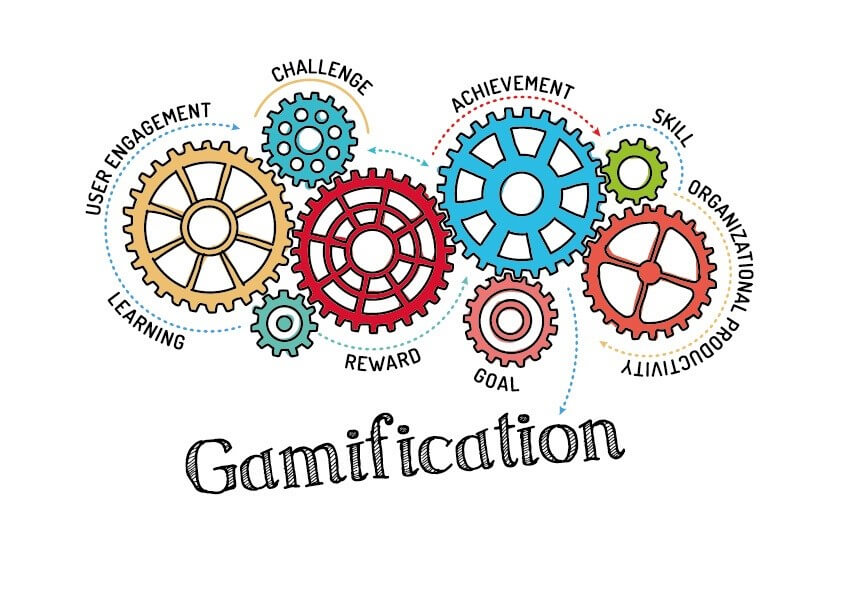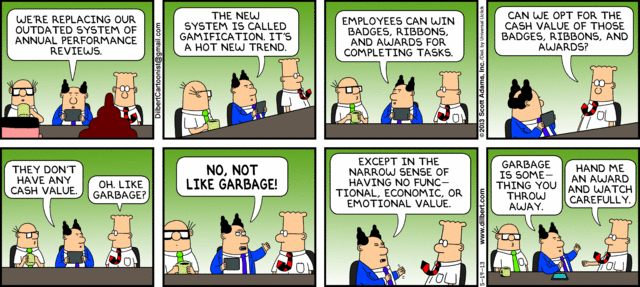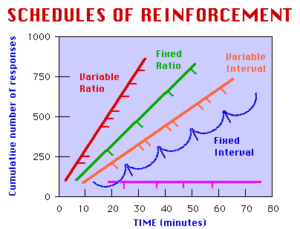
This may come as a shock to you, especially because Snowfly is a gamification-based employee recognition and incentives software company, but the simple answer is: NO (at least not in the way most people think it does).
Okay, I admit, I am being a little bit tongue-in-cheek here because, of course, I do believe that gamification is extremely powerful and effective in the workplace. However, gamification, when deployed in a workplace environment, only creates long-term sustainable results when applied properly.

I will even go so far as to predict that if your current deployment of gamification is what I listed above, you should expect to see (or have already experienced) a huge initial spike in engagement with the program among your employees and then, after about 90-120 days, then a plateau in engagement statistics, followed by a sharp decline in adoption and usage rates as well as effectiveness of your gamification platform. Why??? Because as Dilbert so astutely points out, the rewards of typical gamification programs (badges, ribbons, leaderboards, points, etc.) are “like garbage” because they don’t have any real (i.e. “functional, economic, or emotional”) value.
Gamification-based rewards and recognition, no matter how well-meaning, do not provide the kind of sustainable motivational boost that many employers envisioned when they paid for an expensive points and rewards tracking program if there is not some kind of real value tied to the reward (could be cash value or another kind of tangible value). And in some instances, even if there is real value tied to the reward, if that particular reward doesn’t resonate with the individual who earned and received that reward, it may potentially have a negative effect on that person’s morale and sense of being appreciated.
Imagine someone earning recognition through their employee incentive program and receiving a “prize” in the mail of a $15 gift card to Starbucks. Sounds great right? Except what if that individual doesn’t drink coffee…AT ALL? Now that person not only feels unappreciated because the $15 to Starbuck’s has no value to her, but she also feels like her boss/employer doesn’t really care about her at all because they didn’t even take the time to ask her what type of recognition/reward would matter to her.
In order to provide real value, gamification programs must direct the behavioral responses of those participating towards new norms, and eventually develop new habits and improved thresholds. Here at Snowfly, we affectionately call this “Directed Gamification” because our goal with every one of our clients is to modify employee behavior, in the classical psychology sense, as pioneered by two 20th century behavioral psychologists, Abraham Maslow & B.F. Skinner. Their respective ideas and application of motivational theories have been applied to the workplace with pretty amazing results.

Psychologist Abraham Maslow.
Maslow was the first to create the idea that we as people have a hierarchy of needs and that while the needs at the top of the hierarchical pyramid are the most important, they are completely irrelevant if lower level needs haven’t been met. Applied to gamification, Maslow’s hierarchy of needs clearly tells us that an employee who is struggling to pay his rent and have enough money left over every month to feed his family is not only not going to care at all about the points that he might accumulate in a gamification program, he may actually resent the program completely because it is not meeting any of his basic needs, even if the program is designed to meet a need higher up on the pyramid, like self-actualization. According to Maslow, it’s hard for an individual to worry about his impact on society and the world around him (top of the pyramid) if he struggles with basic needs like food and shelter (bottom of the pyramid).
A properly applied gamification system must address an individual’s needs at multiple levels of the pyramid, and ideally, help a person progress from worrying about her needs at the bottom of the pyramid because those needs are being met, to being able to focus on needs at subsequently higher levels. Small, incremental rewards, that have actual value which resonates with that specific individual are the key to a successfully implemented Directed Gamification based incentive program.

Psychologist B.F. Skinner
Continuing with our Psychology 101 lesson, B.F. Skinner took many of Maslow’s ideas and continued to expand upon them using experiments on rats and pigeons to see if he could meet “basic needs” but deliver rewards or incentives on various schedules of reinforcement to determine if a predictable or unpredictable reward was better at modifying behavior over time. What Skinner discovered was fascinating in the sense that he was able to “train” his animal experimental subjects in such a way that, over time, he created new habits and even new neural pathway connections in their brains that coincided with small tasks they learned to perform.
By creating a “gamified” experimentation tool called “The Skinner Box” in which he was able to alter the habitat of his subjects, Skinner was able to show that the most effective and sustainable schedule of reinforcement which provided the longest lasting behavior change at the lowest cost was a variable ratio schedule, which means that rewards were given when certain behaviors were performed, but only randomly and in varied amounts. This type of reinforcement schedule is so effective because the participant learns that if a certain desired behavior is performed repeatedly and consistently, a reward (or payoff) will come to them eventually, but the key is that the participant doesn’t know exactly when, or exactly the size of the reward, so they continue to perform the desired behavior at a high level until the reward comes.

5 different reinforcement schedules and their effectiveness.
Skinner’s research explains intrinsically why, despite their seemingly random payouts, we as humans are so enthralled with slot machines…the ultimate variable ratio reward system! Gamification programs that employ rewards based upon the Variable Ratio reinforcement schedule are able to create long-term behavioral change at relatively low costs when compared to those programs that reward based upon every instance of an individual performing a repeated behavior. When a behavior is rewarded every time it is performed, with the same “payout” each and every time, the reward then becomes an expectation and an entitlement rather than a incentive for good performance and it has completely lost its value and its ability to motivate someone in the future because once the reward is removed, the behavior stops until the reward is reinstated. Long-term behavior change happens when a performed behavior becomes a new habit as a result of consistent repetition through variable ratio reinforcement, not when a behavior is performed because there is an expectation of a reward to be received – that is bribery.
To read more about how & why implementing an effective Gamification program can be beneficial to your workplace environment, click here to be taken directly to an article that addresses 5 fundamental points to keep in mind when implementing an effective gamification program if you want it to last and actually enact changes within your organization. The 5 key points are: Context, Application, Usability, Engagement & Success Factors.
If you are ready to learn how to employ gamification to create long-term effects and behavioral changes within your organization and/or if you have tried “gamification” before but had a bad experience because it just didn’t work like you expected it to (or were promised it would), we hear you loud and clear! Send us an email at info@snowfly.com and let us show you what directed gamification looks like and help you deploy a gamification and incentive system that provides real value to you and your employees.
Happy Gamifying!

